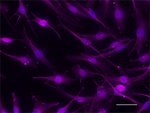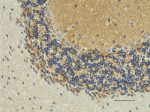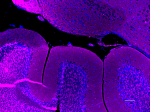- Clone
- SP17 (See other available formats)
- Regulatory Status
- RUO
- Other Names
- SYP, Synaptophysin, Major synaptic vesicle protein P38
- Isotype
- Mouse IgM, κ
- Ave. Rating
- Submit a Review
- Product Citations
- publications

-

IHC staining of Alexa Fluor® 647 anti-Synaptophysin (clone SP17) on formalin-fixed paraffin-embedded human brain. Following antigen retrieval using 1X Citrate Buffer (Cat. No. 420902), the tissue was then incubated with (panels A and B) and without (panels C and D) Alexa Fluor® 647 anti-Synaptophysin (clone SP17). Nuclei were counterstained with DAPI (Cat. No. 422801). Images were captured with a 10X (panels A and C) or a 40X (panels B and D) objective. Scale bar: 50 µm
| Cat # | Size | Price | Save |
|---|---|---|---|
| 837105 | 25 µg | ¥39,600 | |
| 837106 | 100 µg | ¥99,000 |
Synaptophysin, also known as major synaptic vesicle protein P38, is encoded by the SYP gene in humans and is located on the short arm of the X chromosome. Synaptophysin is expressed in neuroendocrine cells as well as all neurons in the CNS that participate in synaptic transmission. Synaptophysin is a synaptic vesicle glycoprotein, and interacts with synaptobrevin. It has been implicated in X-linked mental retardation and can be used as a specific marker for cells of the adrenal medulla and pancreatic islets. As such, it can be used to identify tumors that are derived from those cells, including neuroblastoma, retinoblastoma, medulloblastoma, and others.
Product DetailsProduct Details
- Verified Reactivity
- Human, Mouse, Rat
- Antibody Type
- Monoclonal
- Host Species
- Mouse
- Immunogen
- This antibody was raised against a crude synaptic preparation from post mortem human brain.
- Formulation
- Phosphate-buffered solution, pH 7.2, containing 0.09% sodium azide
- Preparation
- The antibody was purified by affinity chromatography and conjugated with Alexa Fluor® 647 under optimal conditions.
- Concentration
- 0.5 mg/mL
- Storage & Handling
- The antibody solution should be stored undiluted between 2°C and 8°C, and protected from prolonged exposure to light. Do not freeze.
- Application
-
IHC-P - Quality tested
- Recommended Usage
-
Each lot of this antibody is quality control tested by formalin-fixed paraffin-embedded immunohistochemical staining. For immunohistochemistry, a concentration range of 1.0 - 5.0 µg/mL is suggested. It is recommended that the reagent be titrated for optimal performance for each application.
* Alexa Fluor® 647 has a maximum emission of 668 nm when it is excited at 633 nm / 635 nm.
Alexa Fluor® and Pacific Blue™ are trademarks of Life Technologies Corporation.
View full statement regarding label licenses - Excitation Laser
-
Red Laser (633 nm)
- Application Notes
-
SP17 reacts with native, denatured and recombinant synaptic vesicle protein synaptophysin expressed in CHO cells. The antibody is particularly valuable for immunocytochemical studies of the brain due to its stability in formalin sections.
-
Application References
(PubMed link indicates BioLegend citation)
Antigen Details
- Structure
- Synaptophysin is a 313 amino acid protein with an apparent molecular mass of 34 kD.
- Distribution
-
Tissue distribution: Brain, pancreas, adipose and soft tissue, gastrointestinal tract, bone marrow, and immune system.
Cellular Distribution: Plasma and synaptic vesicle membrane. - Function
- Synaptophysin plays a role in synaptic vesicle docking and membrane fusion.
- Interaction
- SRCIN1, also interact with itself to form homohexamer or homotetramer
- Biology Area
- Cell Biology, Neuroscience, Synaptic Biology
- Molecular Family
- Presynaptic proteins
- Antigen References
-
- Zhang L, et al. 2018. Medicine (Baltimore). 97(29):e11487
- Moris, et al. 2018. Anticancer res. 38(2):601
- Hami J, et al. 2017. J pediatr Neurosci. 12(3):215
- Gene ID
- 6855 View all products for this Gene ID
- UniProt
- View information about Synaptophysin on UniProt.org
Related Pages & Pathways
Pages
Related FAQs
Other Formats
View All Synaptophysin Reagents Request Custom Conjugation| Description | Clone | Applications |
|---|---|---|
| Purified anti-Synaptophysin | SP17 | WB,ICC,IHC-P,SB |
| Alexa Fluor® 647 anti-Synaptophysin | SP17 | IHC-P |
Compare Data Across All Formats
This data display is provided for general comparisons between formats.
Your actual data may vary due to variations in samples, target cells, instruments and their settings, staining conditions, and other factors.
If you need assistance with selecting the best format contact our expert technical support team.
-
Purified anti-Synaptophysin

Western blot of purified anti-Synaptophysin antibody (clone ... 
ICC staining of purified anti-Synaptophysin antibody (clone ... 
IHC staining of purified anti- anti-Synaptophysin antibody (... 
IHC staining of purified anti- anti-Synaptophysin antibody (... 
IHC staining of purified anti-Synaptophysin (clone SP17) on ... -
Alexa Fluor® 647 anti-Synaptophysin

IHC staining of Alexa Fluor® 647 anti-Synaptophysin (clone S...












Follow Us